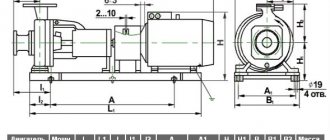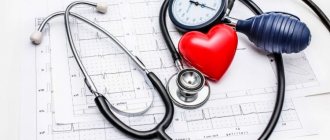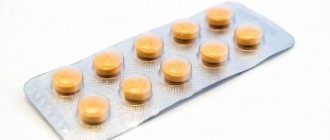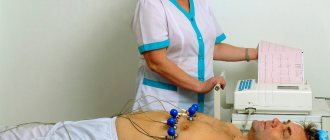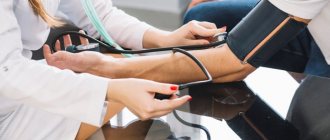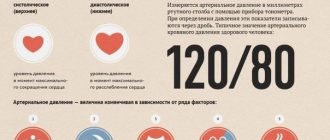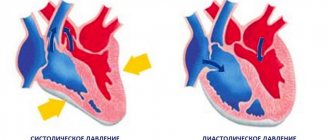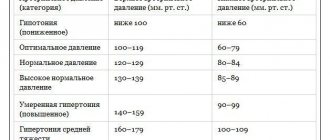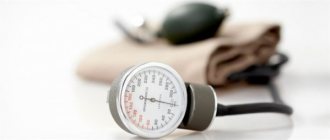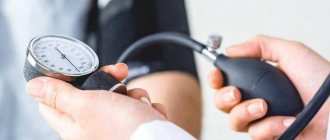What is blood pressure and what does it depend on?
Blood pressure refers to the force of blood pressure on the walls of blood vessels, measured in millimeters of mercury. There are venous, intracardiac, capillary and arterial pressure (BP).
It is blood pressure measurement that has the greatest practical value. The indicator includes two numbers:
- Upper pressure is the effect of blood on the walls of blood vessels during the greatest contraction of the heart, at the moment of blood ejection. The number is fixed when the pressure in the vessels reaches its maximum value.
- The lower pressure, which is recorded at the moment of greatest relaxation of the heart.
The difference between the upper and lower values is called pulse pressure, its norm is 35-50 mmHg. Art.
The value of blood pressure is influenced by:
- Floor. As a rule, women have 10-20 units lower than men.
- Body mass.
- Age. With age, blood pressure increases.
- The presence of bad habits.
- Psycho-emotional state.
- Physiological features, including heart volume.
- Taking certain medications.
- Presence of chronic diseases.
- Diet.
Most doctors are skeptical about averaging blood pressure standards depending on the gender or age of patients, preferring an individual approach in each situation.
How can you raise blood pressure at home?
This is not so difficult to do, but you need to strictly follow the algorithm:
- Measure your blood pressure level and record the numerical value.
- Take a caffeine tablet, maybe two. In the absence of this, Citramon will be used, but it is more dangerous due to the presence of paracetamol in the composition. Both drugs should be in your home medicine cabinet.
- Drink a tonic drink of your choice, you can have strong tea, one or two cups.
- Take a horizontal position, relax and do not make sudden movements to avoid a further drop in blood pressure according to the orthostatic pattern.
If after 20 minutes there is no effect, take tincture of eleutherococcus (one teaspoon), ginseng (30 drops). If you don't have it, lemon with cinnamon and honey in the amount of 3 teaspoons will do.
If after all the actions the blood pressure remains the same, you need to call an ambulance.
We are definitely not talking about a physiological phenomenon. There is a pathogenic process. We need to figure out which one it is.
What to avoid:
- Physical activity.
- Drugs that lower blood pressure (beta blockers, ACE inhibitors, antiarrhythmic drugs and others).
- Hot baths, contrast showers.
- Alcohol.
What is considered normal blood pressure in men and women?
The ideal figure for a person is 120/80. A combination of 120/70 is also considered normal blood pressure.
The upper limit of normal is considered to be 140/90 mmHg. Art. At higher values, an examination is indicated to exclude arterial hypertension. The lower limit is considered to be 90/60 mmHg. Art. If the tonometer shows a lower value, then one may suspect that the person has insufficient blood supply to tissues and organs.
Blood pressure in both arms should be approximately the same, deviation of no more than 5 mm Hg is allowed. Art. A significant difference in values is a sign of the development of atherosclerosis of large blood vessels.
Since the indicator is not stable and depends on many factors, small deviations from generally accepted norms are allowed in the medical community. An indicator whose value falls within the range of 130/80 – 100/60 is considered normal.
The main criterion for the norm is a person’s well-being. Some patients with a pressure of 130/80 experience a headache, and some successfully live with low blood pressure and do not experience discomfort.
Approximate norms depending on age and gender are presented in the table below.
Blood pressure norms by age and gender
| Age/gender | Female | Female | Male | Male |
| top | lower | top | lower | |
| 3-6 | 85-95 (+/-5) | 45-50 (+/-5) | 85-97 (+/-5) | 45-55 (+/-5) |
| 7-10 | 95-105 (+/-5) | 55-60 (+/-5) | 98-105 (+/-5) | 55-60 (+/5) |
| 11-14 | 105-110 (+/10) | 60-65 (+/-5) | 105-110 (+/-10) | 60 (+/-10) |
| Up to 20 | 110-120 | 65-75 | 100-120 | 60-70 |
| Up to 40 | 110-130 | 75-80 | 110-130 | 70-80 |
| Up to 65 | 120-130 | 75-80 | 120-130 | 75-80 |
| older | 135 | 80 | 135 | 80 |
Blood pressure in men is affected primarily by physical and emotional stress, consumption of alcohol, strong tea and coffee, stress, and hereditary predisposition. Deviations from normal values may not be noticed for years, but a figure above 130/80 is a reason to consult a doctor. For athletes, the number 131/84 can be considered the norm.
Blood pressure in women is affected by physiological processes, including pregnancy and breastfeeding. During the period of bearing a child, special attention is paid to measuring blood pressure, since a change in the indicator indicates the presence of pathological processes and disruption of intrauterine development of the fetus.
The lowest rate is in children due to low vascular tone. As you grow older, the circulatory system develops, and blood pressure increases. In adolescence, jumps in numbers are acceptable due to hormonal changes in the body.
In men and women in adulthood, blood pressure increases due to narrowing of blood vessels due to atherosclerotic plaques. After 70 years, indicators begin to decline due to a decrease in the strength and elasticity of blood vessels.
What does a tonometer level of 80/50 mean?
Such blood pressure numbers indicate problems in the body. But not always.
Physiological factors also occur, but their share in the total number of clinically significant situations is quite small, about 30%.
Diseases are much more common, the remaining 70% are problems with the heart, blood vessels, hormonal levels and nervous system, less often the kidneys and excretory tract.
Hypotension does not always carry the same danger. Patients with a chronic increase in blood pressure, as well as people whose normal working pressure is above 130 to 80, experience much greater discomfort, and such a tonometer reading for them is determined by a significant threat.
For your information: the likelihood of complications in patients with hypertension when blood pressure decreases is almost three times higher.
Causes
The causes of hypotension are varied and require detailed study. Timely recognition of the cause of low blood pressure will help to avoid dangerous complications and normalize the patient’s condition without harming health.
In adults and older people
The causes of pressure 80 to 50 in adults and elderly patients are usually divided into physiological and pathological.
Physiological reasons include:
- genetic characteristics that cause chronic hypotension from birth;
- long-term use of medications that have a hypotensive effect;
- long-term adherence to bed rest, low mobility in severe pathologies;
- large blood losses as a result of injuries or surgical interventions.
Pathological reasons:
- age-related changes associated with a decrease in circulating blood volume;
- chronic stress conditions and depression;
- hormonal disorders accompanied by the release of large amounts of adrenaline and acetylcholine into the bloodstream;
- vitamin deficiency, anemia, exhaustion of the body;
- osteochondrosis;
- infectious diseases;
- pathologies of the heart and blood vessels.
Persons prone to fluctuations in blood pressure are recommended to regularly monitor its indicators, measuring them at least twice a day.
In pregnant women
Low blood pressure during pregnancy is primarily associated with hormonal changes in the female body and the formation of a new network of blood vessels, taking into account the needs of the growing fetus.
Hypotension is often observed against the background of toxicosis - frequent vomiting leads to dehydration of the body, which ultimately reduces the filling of blood vessels.
The physique of the expectant mother matters - thin women are more prone to hypotension than women with a “skinny” body. A sedentary lifestyle, which causes circulatory failure in general, helps reduce pressure
In children and adolescents
Pressure 80 to 50 in a child also has a physiological and pathological nature . Physiological hypotension is a consequence of overwork, sudden climate change or active sports with heavy lifting.
And also read on our website: What do blood pressure readings of 150 to 100 mean, how to reduce them, what pills to take, causes and treatment
The following factors can provoke hypotension:
- hereditary predisposition;
- birth injuries;
- chronic infectious lesions;
- frequent colds;
- lack of a rational daily routine;
- lack of minimum physical activity;
- chronic stressful conditions and increased psychological stress.
In hypotensive children, a crisis can be caused by prolonged exposure to a stuffy room, which can lead to dizziness and loss of consciousness.
A sharp decrease in blood pressure from 100 to 60 - first aid
A person's blood pressure is 100 over 60 and is dangerous if it has dropped quickly from normal levels. This happens in the following cases:
- blood loss after injury,
- a consequence of prolonged lying position of the patient,
- severe infections
- diarrhea,
- taking diuretics and antihypertensive drugs,
- internal bleeding from the stomach or intestines,
- physical exhaustion,
- lowering blood glucose in diabetics,
- allergic conditions,
- paroxysmal tachycardia,
- atrial fibrillation,
- myocardial infarction,
- taking drugs.
In such cases, emergency assistance is required. A sharp decrease in blood pressure is dangerous due to disruption of the blood supply to vital organs - the brain, heart.
What to do if your blood pressure drops quickly:
- without wasting time, call an ambulance,
- put the person on his back with his head down, while raising his legs,
- In the hospital, during infections, doctors restore the volume of circulating blood with intravenous drips of saline. At the same time, antibiotics are used
- in case of blood loss after injury, plasma and rehydrants are administered.
Important! Do not try to diagnose on the Internet and treat using traditional methods. Losing time can cost a person his life.
For whom 100 by 60 mm RT. Art. – norm
For most young people, mainly women, a constant pressure of 100 over 60 is normal. This indicator occurs:
- with normal or low weight,
- for non-smokers,
- athletes,
- physically active,
- with constitutional features.
Important! If 100 to 60 remains constant, and there are no complaints and you feel good, there is no need to take therapeutic measures. This blood pressure value does not pose any danger.
Traditional medications for hypotension
We have already figured out what low blood pressure means in an elderly person. This is a serious illness, and it is often impossible to cope with it using only home methods, because... the use of special medications that normalize blood pressure is required. Caffeine remains the most popular remedy for hypotension.
But besides it, other groups of drugs are also used:
- Psychomotor stimulants.
They help an elderly person cope with weakness and chronic fatigue syndrome. Thanks to stimulants, the hypotensive person becomes functional, lethargy and drowsiness disappear, and the normal state is normalized. The most popular drugs from this medicinal group: Sydnofen, Mesocarb, Sydnocarb, etc.
- Analeptic drugs
Improves the functioning of the cardiovascular system and respiratory organs. After using them, older people with low blood pressure begin to feel better, their overall tone and mood improve. This group includes the following drugs: Cordiamine, Centedrin and similar ones.
- Adrenomimetic drugs
These drugs are necessary to increase both diastolic and systolic pressure, so their use is justified only in very difficult cases. They are designed to ensure normal blood circulation. These are Regulton, Gutron, Fethanol, etc.
- Nootropics
This group of products is intended to optimize metabolic processes in the central nervous system and normalize blood circulation. Thanks to taking such medications, an elderly person’s memory improves and the learning process is facilitated. Phenibut, Pantogam, Piracetam, Aminalon, etc. are considered effective nootropic drugs.
We must not forget about the need to take complex vitamin preparations, especially if we are talking about an exacerbation of the disease.
If drug treatment for low blood pressure in older people is carried out at home, it is necessary to strictly adhere to the dosage prescribed by the doctor. If your condition worsens after taking medications, then immediately contact a specialist to adjust treatment taking into account the characteristics of the course of the disease in each individual case.
We recommend
“Nutrition for the elderly: basic principles and rules” Read more
Prevention
Preventive measures to maintain normal blood pressure should be taken by all categories of people, regardless of whether the person is prone to hypotension or hypertension.
And also read on our website: What does blood pressure 160 over 120 mean - causes, symptoms, treatment, prevention
A few important principles:
- Compliance with the work and rest regime.
- Maintaining physical activity, combating physical inactivity, and be sure to do a set of morning exercises.
- A full night's sleep of at least 8 hours.
- A balanced diet with sufficient intake of vitamins, minerals and protein.
- Regular walks in the fresh air.
- Hardening using a contrast shower.
Natural pomegranate and grape juices, compotes from rose hips, rowan berries, lingonberries, and dried apricots help increase hemoglobin and normalize blood pressure.
Hypotonic patients are not recommended to get out of bed quickly in the morning , so as not to provoke a sharp drop in pressure. You need to lie in bed for a couple of minutes, then take a sitting position for another minute, and only then get up.
Read on our website what to do if your blood pressure is: 80 over 40 , 80 over 60 , 90 over 60 and 90 over 70 ?
Is this condition dangerous?
If your blood pressure has dropped sharply to pathological levels, there is reason to seriously think about it. Is it dangerous? An isolated case does not pose a serious threat to human health. But if signs of hypotension are observed regularly and are accompanied by a significant deterioration in health, fainting, nausea and vomiting, it is not recommended to delay a visit to the doctor.
Fluctuations in blood pressure cause a decrease in the elasticity of blood vessels, which ultimately leads to the formation of hypertension. Hypotension in most cases is accompanied by impaired blood circulation and brain activity, leading to exhaustion and malfunction of internal organs.
As a secondary symptom, low blood pressure can signal dangerous conditions such as anaphylactic shock or internal bleeding.
Possible consequences
Among the complications:
- Myocardial infarction. Acute necrosis of cells of the muscular structures of the heart. It begins abruptly and quickly leads to irreversible changes and a fatal decrease in organ activity. Requires treatment. Even if successful, heart failure develops, which leads to death within 3-5 years without complex therapy.
- Stroke. Malnutrition of brain structures. Ischemic type. Hemorrhage is not common. It can also be fatal in the short term.
- Injuries due to falls. Fainting can happen at the most crucial moment. Therefore, patients with uncompensated hypotension should not drive. It is better not to visit potentially dangerous places.
- Cognitive impairment. Decreased memory, attention. Speed and productivity of thinking. The risk of Parkinson's and Alzheimer's diseases also increases (by approximately 6-8%).
- IHD and dysfunctional disorders.
Prevention of complications is one of the main goals of therapy.
Diagnosis and main symptoms
The diagnostic algorithm is simple:
- History taking, physical examination.
- UBC, OAM, blood testing for hormones.
- Tonometry, Holter.
- ECG, EchoCG, EEG.
- MRI.
- Load tests.
- Consultations of narrow specialists.
The list of manipulations can be expanded at the discretion of the doctor. The examination reveals the main symptoms of hypotension:
- weakness;
- headaches and chest pains;
- dyspnea;
- lethargy, apathy;
- digestive disorders;
- tachycardia.
An increase in symptoms with a sharp decrease in pressure indicators threatens a hypotensive crisis requiring emergency assistance.
